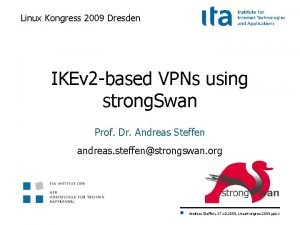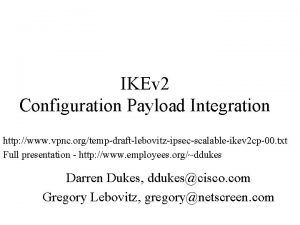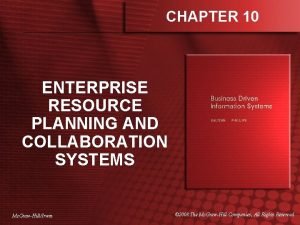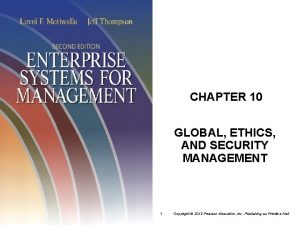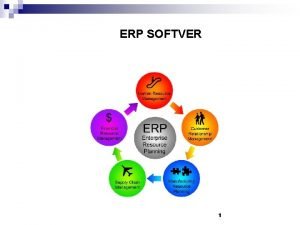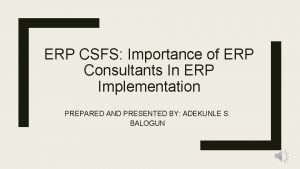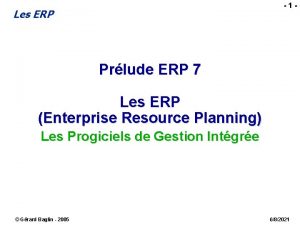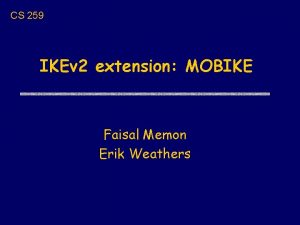ERP for IKEv 2 draftniripsecmeerx01 Why ERP for











- Slides: 11

ERP for IKEv 2 draft-nir-ipsecme-erx-01

Why ERP for IKEv 2? • RFC 5296 and the bis document define a quick reauthentication protocol for EAP. • ERP requires fewer round-trips, so it’s faster. • ERP can be automatic – does not require user interaction. • Having ERP allows a smooth transition between local networks such as 802. 1 x to remote access networking, such as with IKEv 2. This is especially desirable in mobile devices. • However, IKEv 2 (RFC 5996) is not suited for ERP, hence the need for an extension. As section 1 of RFC 5296 -bis says: Specifically, the IEEE 802. 1 x specification must be revised and RFC 5996 must be updated to carry ERP messages.

ERP in the IKEv 2 protocol • Adding ERP was pretty straightforward. Here’s IKE_AUTH: first request --> IDi, SA, TSi, TSr, first response <-- IDr, [CERT+], AUTH, EAP, / --> EAP repeat 1. . N times | <-- EAP last request --> AUTH last response <-- AUTH, SA, TSi, TSr,

ERP in the IKEv 2 protocol • Adding ERP was pretty straightforward. Here’s IKE_AUTH with ERP: first request --> EAP(EAP_Initiate/Re-auth), SA, TSi, TSr, first response <-- IDr, [CERT+], AUTH, EAP(EAP-Finish/Re-auth), last request --> AUTH last response <-- AUTH, SA, TSi, TSr,

ERP in IKEv 2 Protocol • So what’s added? • An “ERP supported” notification in the IKE_SA_INIT response. This replaces the Re-auth-Start message, and may contain the domain name. • ERP in the first IKE_AUTH exchange. • Update RFC 5996 to allow ERP codes. • The domain name is passed in the clear. Probably OK.

Open Issues

Local ER Server for IKEv 2? • RFC 5296 specifies a method-independent re-authentication protocol applicable to two specific deployment scenarios: • where the peer’s home EAP server also performs reauthentication; and • Where a local re-authentication server exists but is collocated with a AAA proxy within the domain. • We’re not convinced that there is a use case for IKE with anything but the first scenario. • Although remote-access IKE is a form of network attachment, it works over the Internet, not the local network, so the home attachment point is reachable • This is very different from 802. 1 x or PPP.

Local ER Server for IKEv 2? • We’re looking for feedback. • Is there a use-case for performing IKE with a local as opposed to a home server? • Yes, I should be asking the IPSECME group, but they’re not meeting this week. • Not too big on responding to the mailing list either… • If the answer is no, then the open issue in the next slide probably becomes moot as well.

User Name in ERP? • IPSec as defined in RFC 4301 defines a very granular policy related to identities. One user may be allowed to send and receive traffic matching a certain traffic selector, while another may not. • With regular EAP the user is identified by either a username or an RFC-822 formatted NAI. • With ERP the only identifier is the key. Name-NAI TLV that looks like 09 c 2360 fc 3 a 4 cd 72@example. com. • The username part of this NAI is a hexadecimal representation of the EMSKname, which is an ephemeral value. • A local ERP server which did not perform the original authentication cannot map this to a user name, and consequently cannot map authorizations.

User Name in ERP? In the first deployment scenario there’s no problem. The ERP server is the same that made the full authentication. It is able to map the ephemeral EMSKname to real username. It can pass the real user name in the Access. Accept message it sends to the VPN gateway. • The VPN gateway can then make authorization decisions based on policy. • • • But what do we do if they ERP servers are not the same?

Questions? Answers?
 Mobike dresden
Mobike dresden Ikev
Ikev Andreas carlsson bye bye bye
Andreas carlsson bye bye bye Dont ask why why why
Dont ask why why why Scm, crm, and erp are all extended erp components.
Scm, crm, and erp are all extended erp components. Ethics in security management
Ethics in security management Fspos
Fspos Novell typiska drag
Novell typiska drag Tack för att ni lyssnade bild
Tack för att ni lyssnade bild Vad står k.r.å.k.a.n för
Vad står k.r.å.k.a.n för Varför kallas perioden 1918-1939 för mellankrigstiden
Varför kallas perioden 1918-1939 för mellankrigstiden En lathund för arbete med kontinuitetshantering
En lathund för arbete med kontinuitetshantering
